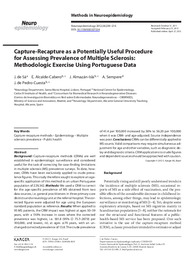Por favor, use este identificador para citar o enlazar este ítem:
https://hdl.handle.net/11000/30556Registro completo de metadatos
| Campo DC | Valor | Lengua/Idioma |
|---|---|---|
| dc.contributor.author | de Sá, J. | - |
| dc.contributor.author | Alcalde-Cabero, E. | - |
| dc.contributor.author | Almazán-Isla, Javier | - |
| dc.contributor.author | Perez-Sempere, Angel | - |
| dc.contributor.author | de Pedro-Cuesta, Jesus | - |
| dc.contributor.other | Departamentos de la UMH::Medicina Clínica | es_ES |
| dc.date.accessioned | 2024-01-22T17:51:34Z | - |
| dc.date.available | 2024-01-22T17:51:34Z | - |
| dc.date.created | 2012-04 | - |
| dc.identifier.citation | Neuroepidemiology Volume 38, Issue 4 | es_ES |
| dc.identifier.issn | 1423-0208 | - |
| dc.identifier.issn | 0251-5350 | - |
| dc.identifier.uri | https://hdl.handle.net/11000/30556 | - |
| dc.description.abstract | Background: Capture-recapture methods (CRMs) are well established in epidemiologic surveillance and considered useful for the task of correcting for case-finding limitations in multiple sclerosis (MS) prevalence surveys. To date, however, CRMs have been exclusively applied to crude prevalence figures. This study therefore sought to explore an age-specific application of this method to an urban Portuguese population of 229,342. Methods: We used a CRM to correct for the age-specific prevalence of MS obtained from two data sources, i.e. general practitioners in three primary-care districts and a neurology unit at the referral hospital. The corrected figures were adjusted for age using the European standard population as reference. Results: When applied to 95 MS patients, the CRM impact was highest at ages 50–59 years, with a 110% increase in cases where the corrected prevalence was highest, i.e. 181.8 (95% CI 75.7–287.9) per 100,000, and lowest, nil, at ages ≥70 years, with an unchanged corrected prevalence of 13.8. The crude prevalence of 41.4 per 100,000 increased by 36% to 56.20 per 100,000 when it was CRM- and age-adjusted. Source independence was poor. Conclusions: CRMs can be differentially applied to MS counts. Valid comparisons may require simultaneous adjustment for age and other variables, such as diagnostic delay and diagnostic criteria. CRM applications to crude figures and dependent sources should be approached with caution. | es_ES |
| dc.format | application/pdf | es_ES |
| dc.format.extent | 8 | es_ES |
| dc.language.iso | eng | es_ES |
| dc.publisher | Karger Publishers | es_ES |
| dc.rights | info:eu-repo/semantics/openAccess | es_ES |
| dc.rights | Attribution-NonCommercial-NoDerivatives 4.0 Internacional | * |
| dc.rights.uri | http://creativecommons.org/licenses/by-nc-nd/4.0/ | * |
| dc.subject | Capture-recapture methods | es_ES |
| dc.subject | Epidemiology | es_ES |
| dc.subject | Multiple sclerosis prevalence | es_ES |
| dc.subject | Public health | es_ES |
| dc.subject.other | CDU::6 - Ciencias aplicadas::61 - Medicina | es_ES |
| dc.title | Capture-Recapture as a Potentially Useful Procedure for Assessing Prevalence of Multiple Sclerosis: Methodologic Exercise Using Portuguese Data | es_ES |
| dc.type | info:eu-repo/semantics/article | es_ES |
| dc.relation.publisherversion | https://doi.org/10.1159/000337534 | es_ES |

Ver/Abrir:
9-Neuroepidemiology (1).pdf
310,12 kB
Adobe PDF
Compartir:
 La licencia se describe como: Atribución-NonComercial-NoDerivada 4.0 Internacional.
La licencia se describe como: Atribución-NonComercial-NoDerivada 4.0 Internacional.
.png)